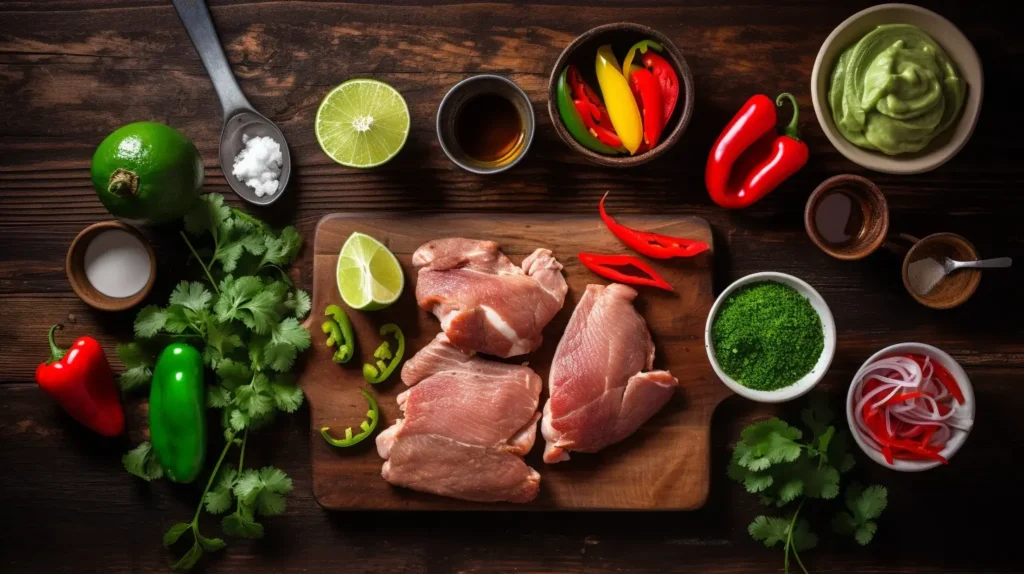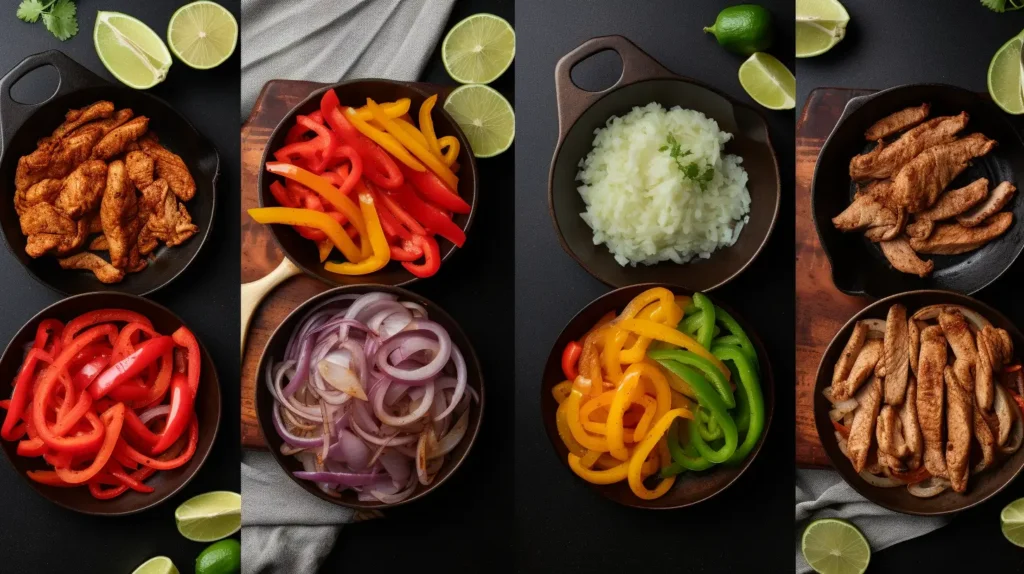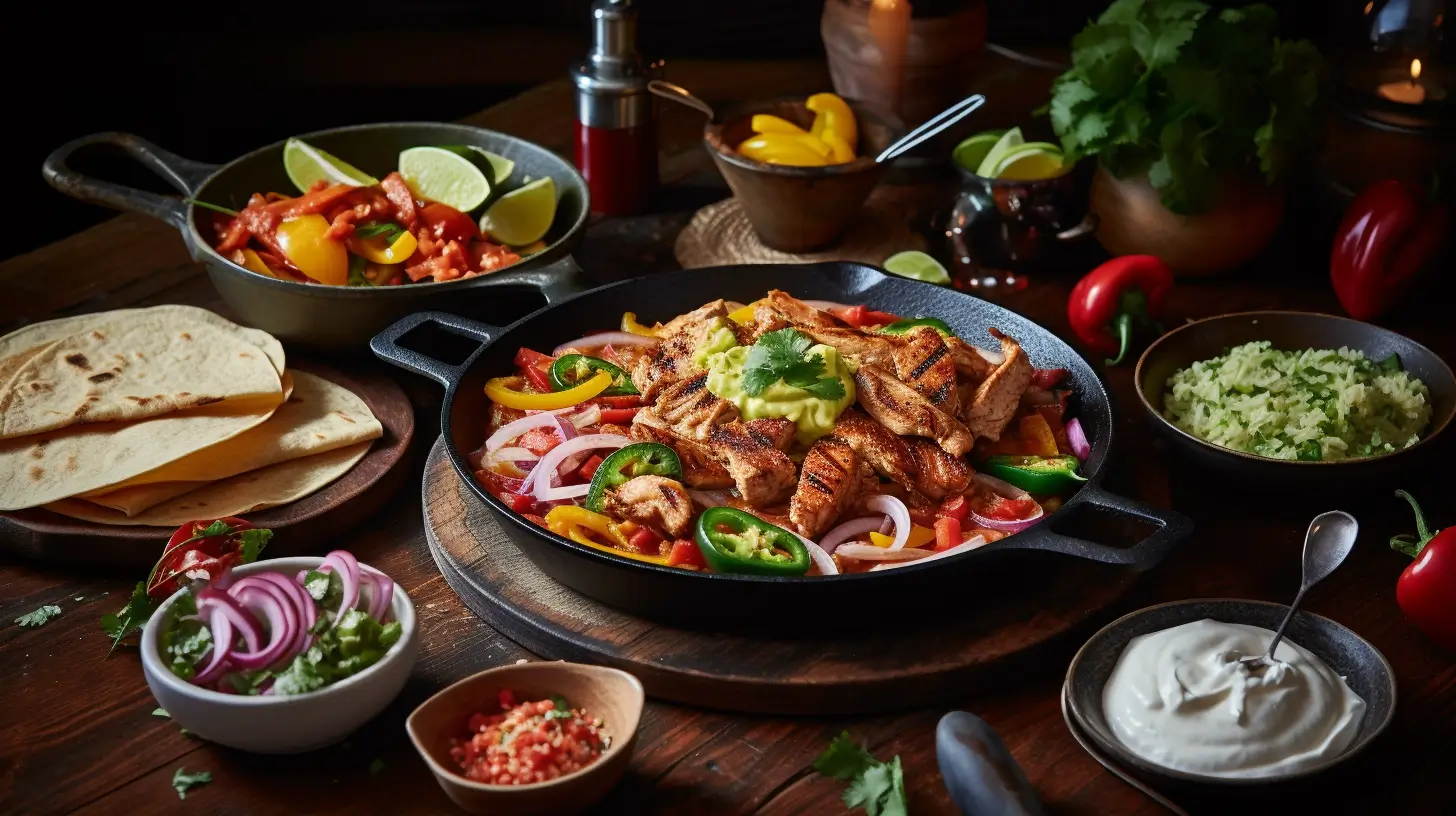Table of Contents
Introduction
You know that satisfying sound of sizzling meat and veggies hitting a hot skillet? It’s almost impossible not to look over, anticipating the meal ahead. Chicken and beef fajitas aren’t just a dinner—they’re a celebration of bold flavors and vibrant colors, all wrapped up in a warm tortilla. Whether you’re hosting a lively dinner party or just looking for a quick family-friendly meal, fajitas are the perfect choice.
For me, fajitas have always been a comfort food. I still remember those fun family dinners where everyone got to customize their own fajitas, piling on toppings and competing over who could create the most colorful plate. Now, you can recreate that magic at home. From perfectly marinated meats to creative serving ideas, this guide covers everything you need to know to make the ultimate chicken and beef fajitas.
For more Tex-Mex inspiration, don’t miss Southwest Chicken Salad: Bold Tex-Mex Flavors for another delicious dinner idea.
What Are Chicken and Beef Fajitas?
A Tex-Mex Classic
Before we dive into the recipe, let’s take a moment to appreciate where fajitas come from. A staple of Tex-Mex cuisine, fajitas blend the rich culinary traditions of Mexican and Texan cultures. The term “fajita” actually comes from the Spanish word “faja,” meaning “strip,” a nod to the thin strips of meat traditionally used in this dish.
Originally made with skirt steak, fajitas have evolved over time to include chicken, shrimp, and even vegetarian alternatives. What hasn’t changed, however, is their signature presentation. The sizzling skillet, the smoky aroma, and the colorful toppings make fajitas a meal that excites all the senses.
Essential Ingredients for Perfect Chicken and Beef Fajitas
To make the perfect fajitas, you’ll need fresh, high-quality ingredients. Each component plays a role in creating the bold flavors and textures that make this dish unforgettable.

The Protein
Your choice of meat is the star of the show, so it’s worth getting it right. Here’s what works best:
- Chicken: Boneless, skinless thighs are ideal for their juicy texture, but chicken breast works well if you prefer leaner cuts.
- Beef: Skirt steak is the traditional choice, prized for its rich flavor and tender texture. Flank steak or sirloin are also great options if skirt steak isn’t available.
Vegetables That Make Chicken and Beef Fajitas Delicious
No fajitas are complete without a mix of vibrant, caramelized veggies:
- Bell Peppers: Use a variety of colors—red, green, and yellow—for a visually appealing and flavorful mix.
- Onions: A large white or yellow onion adds sweetness and depth when sautéed.
Seasonings to Make Your Chicken and Beef Fajitas Flavorful
Seasonings are what transform simple ingredients into a Tex-Mex masterpiece:
- Fajita Seasoning: A blend of chili powder, cumin, paprika, garlic powder, and a touch of cayenne for heat.
- Marinade: Lime juice, olive oil, minced garlic, and spices not only add flavor but also tenderize the meat.
Ingredient Table
| Ingredient | Quantity | Notes |
| Chicken thighs | 1 lb | Boneless, skinless |
| Skirt steak | 1 lb | Sliced against the grain |
| Bell peppers | 3 (mixed) | Thinly sliced |
| Onion | 1 large | Thinly sliced |
| Fajita seasoning | 2 tbsp | Store-bought or homemade |
How to Cook Chicken and Beef Fajitas Step by Step
Making fajitas might feel daunting, but when broken down into easy steps, you’ll see how simple it can be. Here’s how to do it:
Step 1: Marinating Your Chicken and Beef for Tender Fajitas
Begin by mixing your protein with lime juice, olive oil, minced garlic, and fajita seasoning. Let it sit in the refrigerator to marinate for a minimum of 30 minutes. If you have more time, letting it sit for a few hours deepens the flavor even more.
Step 2: Prep the Vegetables
While the meat marinates, slice your bell peppers and onions into thin, even strips. Uniform slicing helps everything cook at the same rate. For more dinner inspiration, Discover Grilled Salmon in Foil: Quick & Juicy Recipe for a healthy and flavorful option.
Step 3: Heat the Skillet
For authentic fajitas, a cast-iron skillet is undoubtedly your best bet. Before you start cooking, make sure to preheat it over medium-high heat so it gets hot enough to deliver a perfect sear and lock in those delicious flavors.
Step 4: Cook the Meat
- Add the chicken or beef to the skillet and sear on each side until golden brown. Chicken should be cooked through, while beef can be cooked to your preferred doneness.
- Remove the meat from the skillet and let it rest for 5–10 minutes before slicing it into strips. Letting it rest gives the juices time to redistribute, ensuring the meat stays tender and moist.
Step 5: Cook the Vegetables
In the same skillet, toss in the peppers and onions. Cook them until they’re tender and slightly charred, which usually takes about 5–7 minutes.
Step 6: Combine and Serve
Add the sliced meat back into the skillet with the veggies. Toss everything together to combine the flavors, and serve immediately.

Delicious Serving Ideas
What’s great about fajitas is how customizable they are. Here are some serving ideas to inspire your next fajita night:
Classic Chicken and Beef Fajitas with Tortillas
Serve your fajitas with warm flour tortillas, guacamole, sour cream, shredded cheese, and salsa. With this setup, everyone can easily customize and build their own fajitas exactly how they like them, making the meal both fun and interactive.
Low-Carb Chicken and Beef Fajitas Without Tortillas
If you’re looking for a lighter option, swap the tortillas for lettuce wraps. They’re crisp, and refreshing, and let the flavors of the filling shine.
Creative Twists
- Fajita Bowls: Skip the tortillas altogether and serve your fajitas over rice, quinoa, or cauliflower rice.
- Fajita Nachos: Spread tortilla chips on a baking sheet, top them with fajita meat and veggies, sprinkle on cheese, and bake until melty.
- Fajita Quesadillas: Sandwich fajita fillings between two tortillas and grill until golden and crispy.
Looking for lighter options? Try these healthy topping ideas for your Tex-Mex dishes to make your meal both nutritious and flavorful.
Tips for Making the Best Chicken and Beef Fajitas
Even the simplest dishes have their secrets. Here are a few tips to make sure your fajitas turn out perfectly every time:
- Marinate Long Enough: Letting the meat soak in the marinade for at least 30 minutes infuses it with flavor. If possible, marinate overnight for even better results.
- Slice Against the Grain: For beef, cutting against the grain makes the meat more tender and easier to chew.
- Use High Heat: A hot skillet is key to achieving that delicious char on the meat and veggies.
- Cook in Batches: If your skillet is small, cook the meat and veggies in batches to avoid overcrowding, which can cause steaming instead of searing.
Conclusion
Chicken and beef fajitas are more than just a meal—they’re a way to bring people together around the table. With their bold flavors, vibrant colors, and sizzling presentation, fajitas turn an ordinary dinner into something special. Whether you’re keeping it classic or trying a creative twist, fajitas are a dish you’ll want to make again and again.
Now it’s your turn. How do you like to enjoy fajitas? Share your favorite tips, toppings, or twists in the comments below, and let’s keep the fajita love alive!
FAQ Section
- Which cut of beef is ideal for making fajitas?
Skirt steak is the traditional choice, but flank steak and sirloin are also great options. - Can I make fajitas ahead of time?
Yes, you can easily prep the ingredients and marinate the meat up to a day in advance. Then, when you’re ready to serve, cook them fresh to achieve the best flavor and texture. - What are good toppings for fajitas?
Popular options to consider include guacamole, sour cream, shredded cheese, pico de gallo, and fresh cilantro. Together, these toppings not only add vibrant flavors but also bring delightful textures to your fajitas, making them even more enjoyable. - Are fajitas gluten-free?
The meat and veggies are naturally gluten-free, which makes this dish an excellent option for those with dietary restrictions. Additionally, to fully complete the meal, you can simply opt for corn tortillas or gluten-free flour tortillas, ensuring that everything remains perfectly gluten-free and delicious. - Can fajitas be frozen?
Yes, you can store cooked fajitas in an airtight container for up to 3 months. When you’re ready to enjoy them again, simply reheat the fajitas in a skillet to restore their best texture and flavor.

